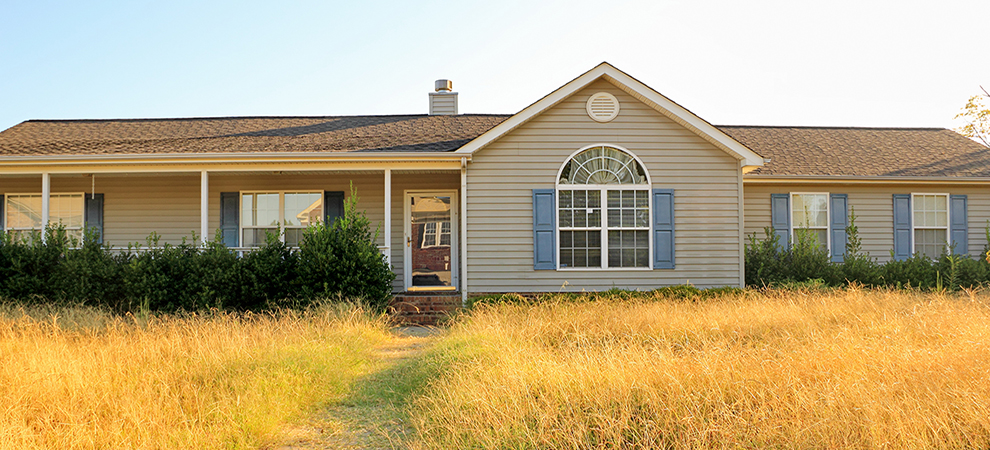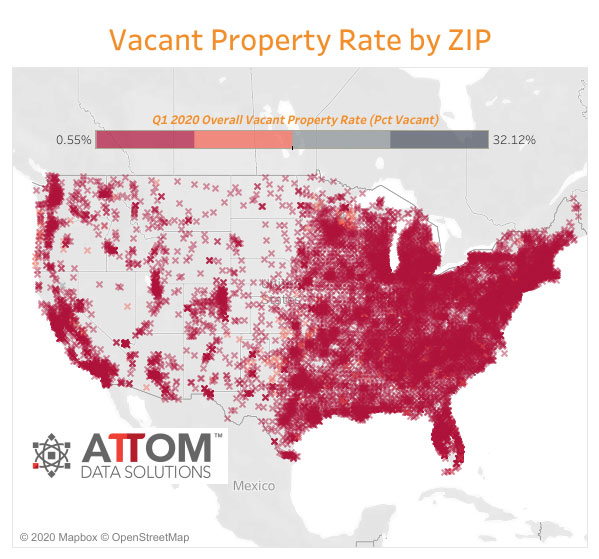The WPJ
THE WORLD PROPERTY JOURNALReal Estate Facts Not Fiction
Residential Real Estate News

Empty "Zombie Home" Foreclosures Uptick 3.1 Percent in U.S.
Residential News » Detroit Edition | By WPJ Staff | March 2, 2020 8:00 AM ET
Based on ATTOM Data Solutions newly released Q1 2020 Vacant Property and Zombie Foreclosure Report, over 1.52 million U.S. single-family homes and condos in the United States are vacant, representing 1.5 percent of all homes.
According to the report, about 282,800 homes are in the process of foreclosure, with about 8,700, or 3.1 percent sitting empty as "zombie" foreclosures. The percentage is up from 3 percent in the fourth quarter of 2019, but still significantly less than 5.8 percent in the first quarter of 2014.
The total number of properties in the process of foreclosure in the first quarter of 2020 is down 1.9 percent from the fourth quarter of 2019, while the number vacant foreclosures is up 1.7 percent, meaning that the level of zombie properties rose while the count of foreclosures dipped. Since 2016, the number facing possible foreclosure is down 27 percent, while the tally of unoccupied properties in the foreclosure pipeline has declined 53 percent.
"Homes abandoned by owners facing a possible foreclosure remain little more than a blip on the radar across the country, as one of the main scourges of the Great Recession continues to show little or no signs of re-emerging," said Todd Teta, chief product officer with ATTOM Data Solutions. "Even with the slight increase in these so-called 'zombie foreclosures,' so far this year, there are still pockets of distress with elevated numbers of abandoned homes. But in yet another reflection of how the national housing market is still booming, you can drive through many towns and not pass a single such property."
High-level findings from the report:

According to the report, about 282,800 homes are in the process of foreclosure, with about 8,700, or 3.1 percent sitting empty as "zombie" foreclosures. The percentage is up from 3 percent in the fourth quarter of 2019, but still significantly less than 5.8 percent in the first quarter of 2014.
The total number of properties in the process of foreclosure in the first quarter of 2020 is down 1.9 percent from the fourth quarter of 2019, while the number vacant foreclosures is up 1.7 percent, meaning that the level of zombie properties rose while the count of foreclosures dipped. Since 2016, the number facing possible foreclosure is down 27 percent, while the tally of unoccupied properties in the foreclosure pipeline has declined 53 percent.
"Homes abandoned by owners facing a possible foreclosure remain little more than a blip on the radar across the country, as one of the main scourges of the Great Recession continues to show little or no signs of re-emerging," said Todd Teta, chief product officer with ATTOM Data Solutions. "Even with the slight increase in these so-called 'zombie foreclosures,' so far this year, there are still pockets of distress with elevated numbers of abandoned homes. But in yet another reflection of how the national housing market is still booming, you can drive through many towns and not pass a single such property."
High-level findings from the report:
- A total of 8,678 homes nationwide are sitting empty as zombie foreclosures in the first quarter of 2020. States that had the greatest zombie foreclosure rate with 500 or more properties in the foreclosure process and 100 or more zombie foreclosures included Ohio (6.8 percent), Indiana (5.1 percent), Illinois (4.7 percent), Oklahoma (4.5 percent) and Maryland (4.3 percent).
- New York continues to have the highest actual number of zombie properties (2,206), followed by Florida (1,390), Ohio (977), Illinois (943), Ohio (823) and Pennsylvania (317).
- Among metropolitan areas with at least 100,000 residential properties, Peoria, IL, continues in the first quarter of 2020 to have the highest percent of zombie foreclosures at 12.7 percent, followed by Cleveland, OH (10.5 percent); Youngstown, OH (9.1 percent); Syracuse, NY (8.8 percent) and Knoxville, TN (8.8 percent).
- Among major metro areas with at least 500,000 residential properties, the lowest zombie foreclosure rates are in San Francisco, CA (0.5 percent); Austin, TX (0.8 percent); Los Angeles, CA (1.1 percent); Boston, MA (1.3 percent) and Philadelphia, PA (1.4 percent).
- The top zombie foreclosure rates in counties with at least 500 properties in foreclosure include Saint Clair County, IL (outside St. Louis, MO) (12.3 percent); Cuyahoga County (Cleveland), OH (12 percent); Baltimore City/County, MD (10.4 percent); Pinellas County (Tampa-St. Petersburg), FL (9.8 percent) and Onondaga County (Syracuse), NY (9.5 percent).
- Among zip codes with at least 100 properties in foreclosure, the highest rates of owner-vacated properties remain concentrated in New York, Florida, Ohio and Illinois. The zip codes with the top percentages are 44108, 44112 and 44105, all in Cleveland, OH; 13601 in Watertown, NY, and 61604 in Peoria, IL.
- The highest levels of vacant investor-owned homes are in Indiana (8.4 percent), Kansas (6.5 percent), Ohio, (6 percent), Minnesota (5.9 percent) and Tennessee (5.5 percent).
- Zombie foreclosures continue to represent just a fragment of 1.52 million vacant homes nationwide, comprising of just one in every 175 properties, or less than one percent.
- The highest overall vacancy rates for all residential properties continue to be in Tennessee (2.6 percent), Kansas (2.6 percent), Mississippi (2.5 percent), Oklahoma (2.5 percent) and Indiana (2.5 percent). The lowest remain in New Hampshire (0.4 percent), Vermont (0.4 percent), Delaware (0.5 percent), Idaho (0.6 percent) and North Dakota (0.7 percent).

Sign Up Free | The WPJ Weekly Newsletter
Relevant real estate news.
Actionable market intelligence.
Right to your inbox every week.
Real Estate Listings Showcase
Related News Stories
Residential Real Estate Headlines
- Las Vegas Area Home Prices Uptick 4.3 Percent Annually in March
- Single-Family Rent Growth in U.S. Trends Upward in 2025
- U.S. Mortgage Rates Tick Down Post Trump Tariffs Commencement
- President Trump's 'Liberation Day' Tariffs Potential Impact on the U.S. Housing and Mortgage Markets
- Baby Boomers Biggest Cohort of U.S. Home Buyers in 2025 as Millennials Decline
- U.S. Monthly Housing Payments Hit Record High in 2025
- U.S. Pending Home Sales Uptick in February
- Global Prime Residential Rent Slowdown Continued in Late 2024
- Ireland Home Price Inflation Hits 8 Year High in Early 2025
- Existing Home Sales in America Uptick in February
- Great Miami Area Residential Sales Decline 15 Percent Annually in February
- Mortgage Rates Uptick in Mid-March, Ending 9-Week Decline in U.S.
- World Property Ventures Builds the Future of Real Estate with New Funding Round
- U.S. Builder Sentiment Declines Amid Economic Uncertainty and Rising Costs
- Black Homeownership Rates in U.S. Enjoy Largest Annual Increase of All Racial Groups
- Wealthy Renters Are Taking Over More of the U.S. Rental Market
- If U.S. Congress Does Not Extend NFIP Soon, Thousands of Daily Home Closings Impacted
- U.S. Mortgage Applications Spike 11 Percent in Early March
- Greater Palm Beach Area Residential Sales Rise in Early 2025
- New Apartments in U.S. Are Leasing at Slowest Pace on Record
- U.S. Mortgage Rates Drop to 4 Month Low in March
- Overall U.S. Mortgage Delinquency Rates Dip in December
- New Tariffs on Canada, Mexico to Impact U.S. Homebuilder Input Costs
- Monaco's Property Market: A Tale of Two Cities
- U.S. Home Purchase Cancellations Surge, 1 in 7 Sales Getting Canceled
- U.S. Pending Home Sales Hit Historic Low in Early 2025
- Greater Miami Area Residential Sales Dip in January
- Governor DeSantis Supports Ending Property Taxes in Florida
- WPV Aims to Become the Berkshire Hathaway of Real Estate Tech
- U.S. Home Sales Slump Continues in January
- Average Americans Spend 38 Percent of Monthly Income on Mortgage Payments
- Switzerland's Safe-Haven Appeal Grows with World's Wealthy Homebuyers
- U.S. Builder Confidence Rapidly Declines in February
- Las Vegas Home Sales Rise 6.7 Percent Annually in January, Condo Sales Dip
- Homebuyer Demand in America Drops to 5-Year Low in Early 2025
- Ownership More Affordable Than Renting in Most U.S. Markets
- The World's First Global Listings Service Launches, Called a GLS
- Home Prices Continue to Rise in 89 Percent of U.S. Metros in Late 2024
- Global Luxury Residential Prices Showed Gradual Improvement in Late 2024
- U.S. Construction Hiring Rate Drops to Lowest Levels in 5 Years
Reader Poll
Marketplace Links
This website uses cookies to improve user experience. By using our website you consent in accordance with our Cookie Policy. Read More





